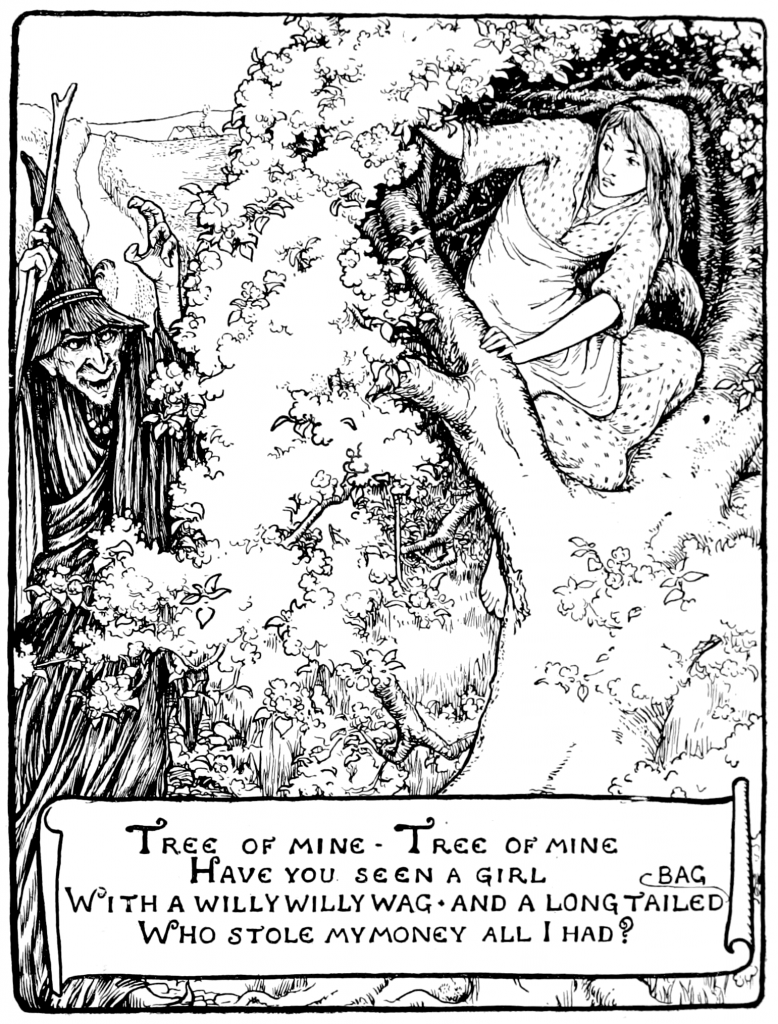
“The Old Witch” is a tale collected by Joseph Jacobs in his 1894 book, More English Fairy Tales. I like it for a couple of reasons, but I’ll save those until I tell how the story goes.
Once there was a couple who had two daughters, but their father had no work. The daughters wanted to go out and seek their fortunes, and one said she would go into service. Her mother said she could, if she could find a place. The daughter searched in town but no one wanted her. She headed farther out into the country and came to an oven full of bread. The bread begged the girl to take it out, and she obeyed. The girl continued and eventually came to a cow that begged her to milk it, which she did, and an apple tree that begged her to shake down its apples, which she did. As I was telling my daughter the other day, if you ever find yourself in a fairy tale and someone or something asks you for help, you should do whatever they’re asking. But if they offer you food or really a free gift of any kind, I would avoid it, you’ll probably end up in their debt if you take it.
Continuing her search, the girl came upon a witch’s house. The woman is quite clearly a witch from the start, not an old woman who we later find out is a witch. The witch took her on as a servant, telling her to keep the house clean and tidy, but forbidding her to ever look up the chimney. One day, the girl “forgot” and looked up the chimney, as was bound to happen. We all know that if you’re told not to do something in these stories, eventually you just have to do it. Bags of money fell down into her lap. The girl immediately gathered them up and fled.
Realizing what the girl had done, the witch chased her but each time she came close to grabbing her, the apple tree and the cow hid her. When the girl came to the oven, the baker hid her behind it, and tricked the witch into the oven, trapping her for a long time. The girl reached her home with the money, married a wealthy man and lived happily ever after.
Her sister decided to try the same thing, but, of course, she refused to help the oven, the cow, and the apple tree. One of them is always more helpful than the other, even though in this case we’re not told that the other sister is particularly mean. She eventually steals the gold too, but when the witch chases her, the apple tree doesn’t respond when she asks for help. The witch caught her, beat her, and took back the money. The girl is sent home, just as poor as she had been before.
I like that it’s girls who are going out to seek their fortune, usually it’s boys who go on the adventure, but I’m a little disappointed that her original aspiration was to find a place as an ordinary servant girl, not even seeking work in a castle. I also like that it uses the standard formula of helping someone without expecting a reward and then receiving help later in return. I’m not sure that choosing to work for a witch was not the best decision, but at least the second girl just got beat up a little, not killed as could so easily have happened.
Thursday’s Tales is a weekly event here at Carol’s Notebook. Fairy tales, folktales, tall tales, even re-tellings, I love them all.

Can’t say I would work for a witch
What a fun story..but didn’t the sister mention how the tree and cow saved her?